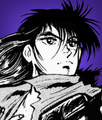The canon timeline of the games are fairly straightforward, as the chronology of the events is generally laid out in the manga, and in the case of the games you can usually base the timeline off of release order. The timeline below will thus be laid out as such.
There are, however, some misconceptions when it comes to the canonicity of the 2014’s Strider, as well as the mystery behind Main Timeline Hiryu’s age.
2014’s Canonicity
Oftentimes, it is seen that Hiryu from both the original manga/games be lumped in with Strider from his 2014 game, although this is incorrect. Although the nature of Hiryu himself is quite mysterious and untold, there are things to be brought up that showcase why he cannot be put into one singular profile.
I will be citing article featuring Capcom directors James Vance and Andrew Szymanski
Many reasons why people will count Strider as canon with the rest of the series, is this following quote:
“But don’t consider this a reboot of the franchise or even Strider 3, it’s a retelling of the core Strider story.”
The quote directly states not to count Strider (2014) as a reboot of the series, but also not to consider it as a Strider 3. This seems confusing, almost contradictory, as it’s either within the same continuity or not. This question is thankfully answered in the following quote:
“. . . So for us [this new game] is a retelling of that, you know, those same events, in a new form.”
It’s directly stated to be a retelling of the Strider story. While it is extremely confusing that they say it isn’t a reboot, a retelling is essentially a reboot. The point they were likely trying to get across is that Strider (2014) isn’t replacing the old canon, but does have its own continuity. In other words, a retelling.
Other things giving away that this cannot exist within the same continuity would be the portrayal of the character Hien. In the original timeline, Hien was a fallen Strider who served under Grandmaster Meio and worshipped him as a God. In the 2014 timeline, Hien was simply a Strider who died attempting to infiltrate Meio’s Third Moon; a direct contradiction.
They are clearly two different continuities that run on their own canons, even if the creators refuse to call Strider (2014) a reboot.
Hiryu’s Age
Hiryu’s age throughout the series is a massive point of contention amongst fans, as it gets quite muddled and confusing in Strider 2. The major argument that arises between people is: Is Hiryu from Strider 2 a new Strider with the old Hiryu’s name, or is he the same man but two thousand years older?
I think there is reason to believe it is the latter, but to say it up front; there is no concrete answer. It is purely up to interpretation. All that can be done is to explain why Strider 2’s Hiryu will be considered the same Hiryu.
The major argument levied against him being the same guy (aside from him being two thousand years old) would be a statement from the Strider Hiryu Visual Chronicle, which states that the Hiryu who appears in Strider 2 shares the same codename as the Hiryu from previous titles.
This shouldn’t be seen as direct confirmation that they are the same guy, however. The quote specifically leaves it vague, stating that he has the same codename but not that he is a new Strider. It was intentionally left vague.
And truthfully, that is the only official material there is to solve this burning question, and it leaves it completely up in the air. So there needs to be something out there to at least lean it to one side or the other, so that a decision can be made.
The answer actually comes in the form of a quote from Marvel vs. Capcom: Infinite, spoken by Hiryu himself.
“I have fought the Grandmaster for a thousand years, dying a thousand death, as if my fate is forever bound to his.”
This directly confirms one of the two possible answers; Hiryu from Strider 2 is the same Hiryu from the previous titles, and has simply lived for nearly two thousand years.
Granted, Marvel vs. Capcom: Infinite is not an official source, nor is it canon to the main timeline, but it is simply the only actual answer given; since every official answer is painfully vague.






